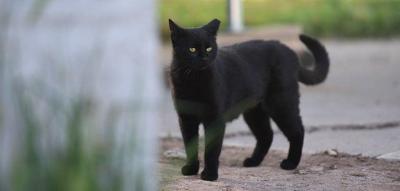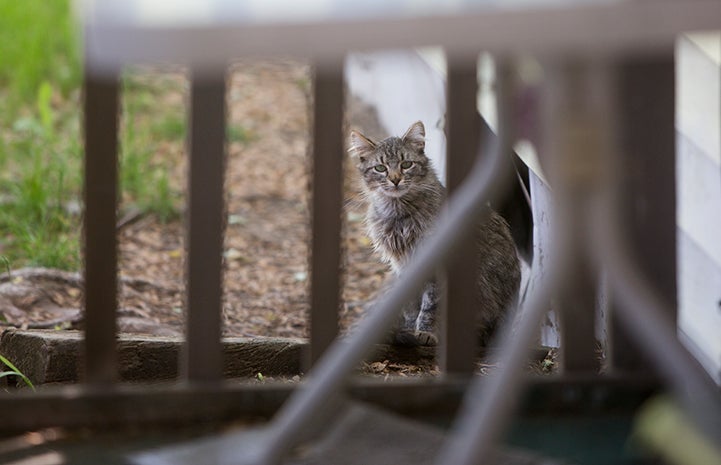
What Every Policymaker Should Know About Community Cats
If you see a cat outdoors, the cat could be stray, feral, or free-roaming. Those terms are often used interchangeably by the general public when referring to cats who live outdoors. At Best Friends Animal Society, we like to call these outdoor cats "community cats" because they are valued members of our community and are often cared for by community members.
Trap-neuter-vaccinate-return (TNVR) is a common-sense, cost-effective solution for managing community cat populations by preventing additional births — rather than trying to round up, house, feed, and kill more cats. Despite TNVR becoming increasingly popular over the past few decades, a great deal of misinformation exists regarding TNVR programs and community cats in general.
To deliver the services your community expects as a policymaker, you need to know the facts.
Community cat fact vs. fiction
Fiction: TNVR is too costly to be feasible.
Facts: Studies show that TNVR can actually save taxpayers money. A review of data from Hillsborough County Animal Services (HCAS) in Tampa, Florida, for example, found the cost to sterilize and vaccinate colony cats to be $65 per cat “as opposed to $168 for (HCAS) picking up, handling, and disposing of an animal.”1 This is similar to cost estimates from San José Animal Care and Services in California, which reports a cost of approximately $72 per cat for “vaccinations against rabies and other common cat disease, flea treatment, ear treatment, microchip, and ear-tipping.”2
Estimates compiled from across the U.S. by researchers with the Alliance for Contraception in Cats & Dogs indicate less of a cost difference — but with TNVR still more economical (about $20–$97 per cat) than the traditional impoundment and lethal injection (about $52–$123 per cat).
Dr. Donna M. Alexander, administrator for Cook County (Illinois) Animal and Rabies Control, has testified in court that “prior to adoption of the TNR programs, local municipalities were trapping and euthanizing approximately 500 to 600 feral cats per year, at a cost to taxpayers of about $135 per cat.” Implementation of the county’s TNR program, then about five or six years old, “had saved the county over $1.5 million, primarily resulting from having fewer feral cats to euthanize.”3
Fiction: TNVR leads to nuisance complaints from residents.
Facts: A well-run TNVR program generally reduces nuisance complaints — sometimes dramatically. Summarizing their review of the relevant research, the authors of a 2013 report from the Alliance for Contraception in Cats & Dogs write: “Credible studies indicate that neutering reduces urine spraying and roaming in search of mates by male cats, and spaying eliminates estrous-associated behaviors in female cats, including aggression, vocalization and perhaps efforts to escape outdoors in order to mate.”4
Fiction: Residents are opposed to TNVR for managing community cats in their neighborhood.
Facts: Results of a 2014 national survey commissioned by Best Friends revealed a 68% preference for TNVR over impoundment followed by lethal injection of unadoptable cats (24%).5 More recently, a 2017 survey (also commissioned by Best Friends) found nearly identical results: 72% of respondents supported TNVR, compared to just 18% favoring impoundment and lethal injection.
Home starts with you
Results of a 2006 survey commissioned by Alley Cat Allies found that 81% of respondents thought “leaving a cat where it is outside” was more humane for the cat, compared to the alternative of “having the cat caught and then put down” (14%).6
When respondents were asked the same question — but told to assume the cat would die two years later after being hit by a car — the support for “leaving the cat” remained strong, at 72% (with 21% preferring to have the cat caught and euthanized).
The same questions were asked in two subsequent surveys, and the results again indicated a strong preference (e.g., 73–86% of respondents for the first question) for “leaving the cat where it is outside.”7,8
Such attitudes are in line with the results of a 2011 national survey in which just 25% of respondents agreed that animal shelters “should be allowed to euthanize animals as a necessary way of controlling the population of animals.”9

Fiction: TNVR doesn’t work.
Facts: The science is quite clear: There are only two ways proven to reduce, and eventually eliminate, a population of community cats: intensive TNVR efforts or intensive eradication efforts, such as those done using poison, disease, lethal trapping, and hunting on small oceanic islands.10,11 Given the horrendous methods employed — and costs that can exceed $100,000 per square mile12 — eradication is a nonstarter in the U.S.
The only fiscally sound option, then, is TNVR. Arguments about the limitations of its effectiveness, the alleged impact of outdoor cats on the environment, and so forth largely miss the point. In the vast majority of instances, TNVR is simply the best option available to humanely reduce the outdoor cat population and any related nuisance complaints.
A number of TNVR program success stories have demonstrated dramatic population reductions and, in some cases, have completely eliminated community cat colonies.
Literature cited
(1) Hamilton, F. E. Leading and Organizing Social Change for Companion Animals. Anthrozoös 2010, 23 (3), 277–292.
(2) Johnson, K. L.; Cicirelli, J. Study of the Effect on Shelter Cat Intakes and Euthanasia from a Shelter Neuter Return Project of 10,080 Cats from March 2010 to June 2014. PeerJ 2014, 2, e646.
(3) County of Cook v. Village of Bridgeview; 2014.
(4) Moldave, K.; Rhodes, L. Contraception and Fertility Control in Dogs and Cats; Alliance for Contraception in Cats & Dogs, 2013.
(5) Wolf, P. J. New Survey Reveals Widespread Support for Trap-Neuter-Return. Humane Thinking 2015.
(6) Chu, K.; Anderson, W. M. Law & Policy Brief: U.S. Public Opinion on Humane Treatment of Stray Cats; Alley Cat Allies: Bethesda, MD, 2007.
(7) Beall, A. E. Community Cats: A Journey into the World of Feral Cats; iUniverse, 2014.
(8) Robinson, B. Letter: How to Manage Green Bay’s Feral Cats. Green Bay Press Gazette. January 25, 2018.
(9) Karpusiewicz, R. AP-Petside.Com Poll: Americans Favor No-Kill Animal Shelters. 2012.
(10) Bester, M. N.; Bloomer, J. P.; Aarde, R. J. van; Erasmus, B. H.; Rensburg, P. J. J. van; Skinner, J. D.; Howell, P. G.; Naude, T. W. A Review of the Successful Eradication of Feral Cats from Sub-Antarctic Marion Island, Southern Indian Ocean. South African Journal of Wildlife Research 2002, 32 (1), 65–73.
(11) Ratcliffe, N.; Bell, M.; Pelembe, T.; Boyle, D.; Benjamin, R.; White, R.; Godley, B.; Stevenson, J.; Sanders, S. The Eradication of Feral Cats from Ascension Island and Its Subsequent Recolonization by Seabirds. Oryx 2009, 44 (01), 20–29.
(12) Campbell, K. J.; Harper, G.; Algar, D.; Hanson, C. C.; Keitt, B. S.; Robinson, S. Review of Feral Cat Eradications on Islands. In Island invasives: eradication and management; Veitch, C. R., Clout, M. N., Towns, D. R., Eds.; IUCN: Gland, Switzerland, 2011.
